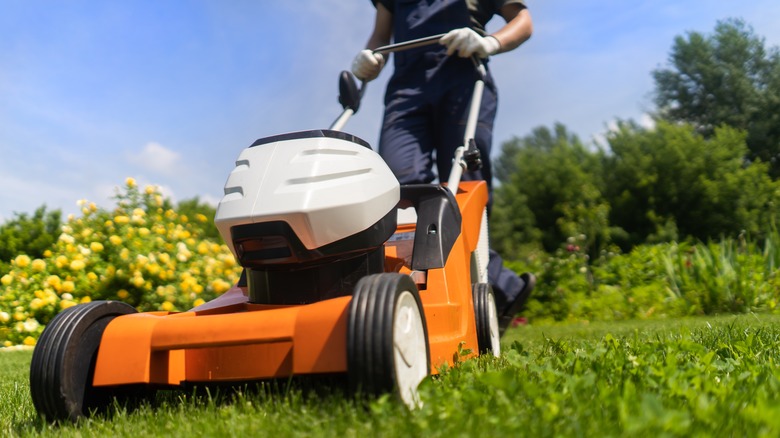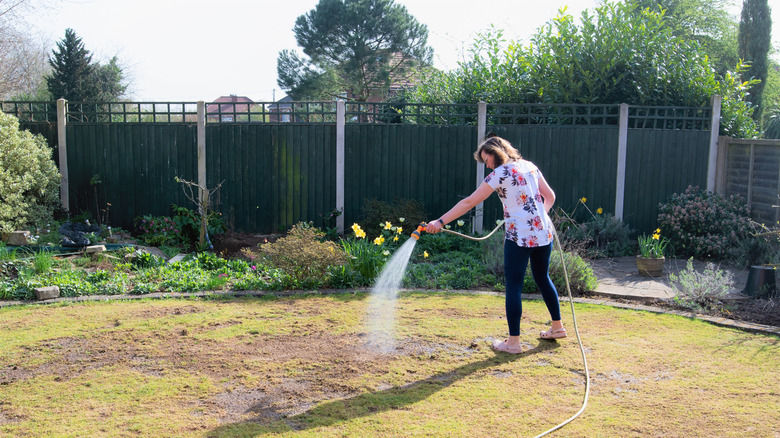Sorry, But Mowing Your Lawn More Frequently Really Does Have A Big Benefit
Welcome to the prime of lawn mowing season! Here, we have overgrown grass, sunny weather, and a laundry list of outdoor tasks. Much like the degree of heat that amps up in the spring and summer, the length of our grass grows tall and wide throughout our yard due to a natural overload of sunlight and water. After your first mow of the spring, lawn maintenance calls for a weekly mow, which may have you considering the importance of frequent lawn mowing. Contrary to what you may believe, frequent lawn mowing has a major benefit on the thickness and growth of grass. To grow a healthy lawn without harsh chemicals, you must rely on lawn mowing more than you already may.
Before we get started on the whys and hows of frequent lawn mowing, it's important to note that not all grass is created equal. While most grass thrives in warm and sunny environments, cool-season grass — like Kentucky bluegrass, tall fescue, ryegrass, and bentgrass — thrives in cooler climates. Warm-season grass — such as bermudagrass, centipedegrass, and zoysiagrass — prefers the humidity and sunlight that comes with warmer climates. As the temperature gets warmer in the U.S., you'll want to follow a specific protocol so that you can benefit from mowing your lawn more frequently.
Frequent mowing during early spring and summer
Frequent mowing starts by knowing all the benefits of doing so. For starters, the process of photosynthesis is essential for healthy grass. When you frequently buzz over the turf of grass in your yard, it exposes the grass to the amount of sunlight it needs to thrive. The sniped grass blades fall back onto the turf and enhance growth by putting nitrogen back into the soil. While tall grass makes it easy for garden pests to hide in and chew through your grass, frequent mowing still calls for tactfulness since over-mowing (also known as scalping) can create a breeding ground for weeds. Thus, try to keep your lawn between 2 and 3 inches tall.
One way to use frequent mowing to your advantage is by mowing in different directions. Mowing grass in the same direction trains the blades to continue growing together, but by incorporating a variety of directions, you'll encourage grass to stand up straight on its own. Mowing your lawn in a variety of directions also allows for more space where additional grass and leaves can grow, leading to thicker and softer grass blades.
Additional tips to benefit your lawn
It may seem obvious, but adequate water is essential for a healthy lawn. If you have been neglecting your lawn care, consider turning on a sprinkler every 2 to 3 days in the morning to efficiently water your lawn (ideally when the sun is also up). Then, after a few days of watering the lawn, apply fertilizer to the soil to encourage healthy growth. The lawn care process will also encourage you to address the specific problems at hand — for example, if your lawn is plagued with weeds, you may consider incorporating weed control into your weekly lawn care. Herbicides can get rid of undesired plants while still protecting your lawn.
If you have the means to invest in further lawn care and damage prevention, conducting a soil test is another effective way to address any issues with your lawn and garden. You'll learn the pH level of your soil, what nutrients it's lacking, and the organic matter you've preserved. Another handy care practice you may benefit from is reseeding your lawn in patches where the grass is thin. Once you've handled any traces of weeds, reseeding can be a great way to grow back what's been damaged.


